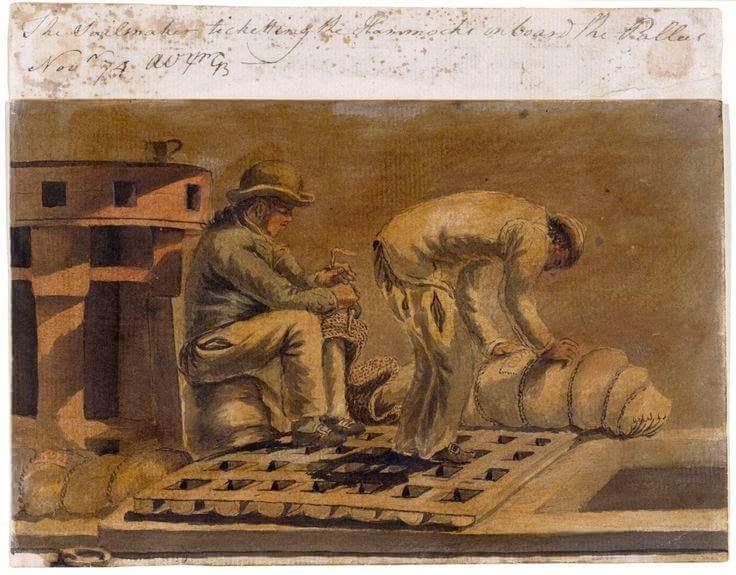A Layman’s Guide to Historic Research
This week after a few weeks of rather heavy research and unit development blogs, writer Kyle Timmons joins us again to welcome back the website with a light hearted research blog. If you've missed the blog, it is back! Thanks for standing by us.
Mary Sherlock - An attached follower of the 17th Regiment of Infantry.
Just a disclaimer to start off with: I AM NOT A HISTORIAN, HISTORY TEACHER, RESEARCHER, ARCHAEOLOGIST, OR ANYTHING LIKE IT. I am a simple person who enjoys history immensely and I’ve read and studied history much of my life. HOWEVER, I have the honor and privilege of being friend and acquaintance to many truly gifted and highly regarded Professional Historians. They’ve taught me so much about the 18th Century, the Revolution, and the British Army. But most importantly, they’ve given me the tools research on my own and to hunt down information that is of interest to me, and hopefully I can turn that information around and further benefit the hobby, the community, and our understanding of the 18th century. I’m going to take some time and share some of those tools with you.
- BE SUSPICIOUS. The moment that you read that previous statement is gone, and is never coming back. You can’t change it. But in an hour when you’re eating delicious food and playing on your phone you’ll likely forget about it. Maybe tomorrow you’ll share your memory of this blog with a friend, but you’ll share the points in your own words. You might get things wrong. 60 years from now when you’re telling your grandchildren how you first got into reenacting you’re memory of the antiquated computer or smart phone you used back then will be colored by nostalgia of the past.
 That’s how history is written. It’s mis-remembered, its colored by the writer’s opinion, maybe inflated by his need to tell a good story, or he’s recording it through hazy lens of old age. Whenever you read a historic source, always keep in mind who is writing it, his goal when writing, and his frame of mind, and when he’s writing. A journal entry or letter written the same day is a great source but even then things can get jumbled, misrepresented, summarized, etc. Your solution to this problem? Find more sources. 1 guy saying the British marched at the open order in battle in 1777 is an anomaly. 2 sources is a little better. 3 is better. Finding details that agree from opposing sides is even better. General Orders recorded in an orderly book detailing how the army is to be deployed just adds more ammunition to your theory.
That’s how history is written. It’s mis-remembered, its colored by the writer’s opinion, maybe inflated by his need to tell a good story, or he’s recording it through hazy lens of old age. Whenever you read a historic source, always keep in mind who is writing it, his goal when writing, and his frame of mind, and when he’s writing. A journal entry or letter written the same day is a great source but even then things can get jumbled, misrepresented, summarized, etc. Your solution to this problem? Find more sources. 1 guy saying the British marched at the open order in battle in 1777 is an anomaly. 2 sources is a little better. 3 is better. Finding details that agree from opposing sides is even better. General Orders recorded in an orderly book detailing how the army is to be deployed just adds more ammunition to your theory.
- YOU MAY BE WRONG BUT YOU MAY BE RIGHT. The modern age we live in is actually an exciting time for someone with a history interest. That’s because high definition imagery and the internet are making it easy for someone in the United States to view an artifact or painting housed in England, or Germany, or anywhere else in the world in detail from the comfort of their home. Books, journals, etc. that are no longer in print or are one of a kind have likewise been digitized and can be accessed around the world either as open domain files or through special archives. This means information that has either laid unseen in a private collector’s library, or has only been accessible to a select few can now be accessed by the entire world. This tidal wave of new information is changing how we see the 18th century in numerous ways. A good example of this is the silk bonnet. Earlier it was commonly believed by reenactors that a silk bonnet was something that would have been out of reach to the “lower sort” of women in the 18th Now however, after searching through runaway ads here in America, looking at artwork from England, it’s clear that these beautiful articles of clothing were available to a much wider range of women than was originally supposed. Our knowledge of the 18th century is largely a collection of theories; strong theories mind you, and ones back up with multiple bits of data to support them. But as the data changes, our conclusions must change as well.
- IMAGINATION IS NO SUBSTITUTE FOR KNOWLEDGE. Even without photographs, film, or with the amount of material culture items industrial-age historians are accustomed to there is a very large amount of source material and artifacts from the 18th There is no excuse for not making use of this material. When you choose an impression, be specific about what it is you’re trying to do. Are you doing a civilian or military? What nationality? What year and where are they? What is their social class? All of this is important. Military clothing, though it follows the fashions of the time, is distinct in many ways from its civilian counterparts. You won’t find examples of civilians in 1777 Philadelphia wearing gaitered trousers. The nation is important because every nation has their own idiosyncrasies. Time and place also play a factor. Fashions, like today, change with time.
 Most military units have to get new clothing from year to year because their clothing wears out, just like yours does (though I doubt you’re marching for miles every day or sleeping outside in the rain!). That means they’re style of clothing is likely to change, either from fashion or from lessons learned on the battlefield. If the unit you’re recreating DIDN’T get their clothing issue than that in itself will change how you represent that unit.
Most military units have to get new clothing from year to year because their clothing wears out, just like yours does (though I doubt you’re marching for miles every day or sleeping outside in the rain!). That means they’re style of clothing is likely to change, either from fashion or from lessons learned on the battlefield. If the unit you’re recreating DIDN’T get their clothing issue than that in itself will change how you represent that unit.
Social class is also of major importance. Some clothing item are compatible to some extent across the classes. For instance, men’s shirts of the day are universally of a good quality in terms of stitch work (though they are often made of different grades of material). In other ways they’re very different. A laborer isn’t likely to be wearing a silk coat and breeches. Likewise, a gentleman isn’t likely to have an osnabrig (a kind of course natural linen) shirt and the same clothing items as a private soldier in the army (any army). Doing any impression costs money. To do a higher class impression well costs more money, just like how it’s easier to get a suit from Boscov’s (like me!) than to have one tailored to your desires in London or L.A.
- QUALITY IS A QUANTITY ALL ITS OWN. This is the last point I want to make. I’m immensely proud of my impressions, of which I have two…and a half. I have a 17th Regiment soldier’s kit, a kit for the Philadelphia Associators, and a mostly finished civilian impression. I say “mostly finished” because my coat is sitting sleeveless and partially un-lined on a chair. The reason I’m immensely proud of my kit is that I’ve made much of the clothing items I possess. My 17th Regimental and its waistcoat were the first 2 sewing projects I’d ever done. The things that I didn’t make were made by friends of mine who are very skilled at their trades. That’s what makes a good 18th century impression. Clothing of the time was done by hand, not machine, and most men’s clothing is fitted. You can see this in the paintings and sketches of the time. Clothing was expensive for these people, and they took care of what they had. They also dressed as well as they could. You should, too. If you’re new to this period, or reenacting in general, my advice for you is this. If you’re thinking of buy “off the rack” clothing, don’t. Save your money. Reenacting isn’t going anywhere. There are people out there who will take your measurements and whip you up a set of period clothing. Many of them are really good, and naturally they charge for that service. It might take you time to get that money together but the quality will be worth it and you won’t have to go and buy a better piece of clothing down the road.

If you have an aptitude for sewing however, or you can get with a group of people who know how to sew and can teach you, then you’re life probably just got a lot easier. With the right patterns for your clothing, patience, and help, you can make your own clothing for a much more agreeable sum of money. On top of that, you learn a valuable skill. And once you can sew, you can make yourself into anyone!
The study of history and the recreation of it is a noble hobby. But to do it right takes work, research, money and commitment. But most importantly, it takes networking with good people. That’s how I have learned so much, and really it’s the people we hang out and work with that make this hobby so great.
 KYLE TIMMONSis a long time reenactor, a Combat Medic in the PA National Guard, and currently an employee of the National Park Service. His wife and cat think he's pretty alright.
KYLE TIMMONSis a long time reenactor, a Combat Medic in the PA National Guard, and currently an employee of the National Park Service. His wife and cat think he's pretty alright.

